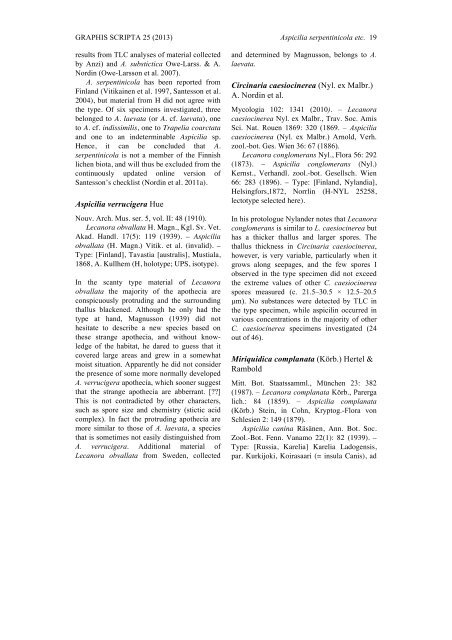On Aspicilia serpentinicola and some other Aspicilia names
On Aspicilia serpentinicola and some other Aspicilia names
On Aspicilia serpentinicola and some other Aspicilia names
You also want an ePaper? Increase the reach of your titles
YUMPU automatically turns print PDFs into web optimized ePapers that Google loves.
GRAPHIS SCRIPTA 25 (2013) <strong>Aspicilia</strong> <strong>serpentinicola</strong> etc. 19<br />
results from TLC analyses of material collected<br />
by Anzi) <strong>and</strong> A. substictica Owe-Larss. & A.<br />
Nordin (Owe-Larsson et al. 2007).<br />
A. <strong>serpentinicola</strong> has been reported from<br />
Finl<strong>and</strong> (Vitikainen et al. 1997, Santesson et al.<br />
2004), but material from H did not agree with<br />
the type. Of six specimens investigated, three<br />
belonged to A. laevata (or A. cf. laevata), one<br />
to A. cf. indissimilis, one to Trapelia coarctata<br />
<strong>and</strong> one to an indeterminable <strong>Aspicilia</strong> sp.<br />
Hence, it can be concluded that A.<br />
<strong>serpentinicola</strong> is not a member of the Finnish<br />
lichen biota, <strong>and</strong> will thus be excluded from the<br />
continuously updated online version of<br />
Santesson’s checklist (Nordin et al. 2011a).<br />
<strong>Aspicilia</strong> verrucigera Hue<br />
Nouv. Arch. Mus. ser. 5, vol. II: 48 (1910).<br />
Lecanora obvallata H. Magn., Kgl. Sv. Vet.<br />
Akad. H<strong>and</strong>l. 17(5): 119 (1939). – <strong>Aspicilia</strong><br />
obvallata (H. Magn.) Vitik. et al. (invalid). –<br />
Type: [Finl<strong>and</strong>], Tavastia [australis], Mustiala,<br />
1868, A. Kullhem (H, holotype; UPS, isotype).<br />
In the scanty type material of Lecanora<br />
obvallata the majority of the apothecia are<br />
conspicuously protruding <strong>and</strong> the surrounding<br />
thallus blackened. Although he only had the<br />
type at h<strong>and</strong>, Magnusson (1939) did not<br />
hesitate to describe a new species based on<br />
these strange apothecia, <strong>and</strong> without knowledge<br />
of the habitat, he dared to guess that it<br />
covered large areas <strong>and</strong> grew in a <strong>some</strong>what<br />
moist situation. Apparently he did not consider<br />
the presence of <strong>some</strong> more normally developed<br />
A. verrucigera apothecia, which sooner suggest<br />
that the strange apothecia are abberrant. [??]<br />
This is not contradicted by <strong>other</strong> characters,<br />
such as spore size <strong>and</strong> chemistry (stictic acid<br />
complex). In fact the protruding apothecia are<br />
more similar to those of A. laevata, a species<br />
that is <strong>some</strong>times not easily distinguished from<br />
A. verrucigera. Additional material of<br />
Lecanora obvallata from Sweden, collected<br />
<strong>and</strong> determined by Magnusson, belongs to A.<br />
laevata.<br />
Circinaria caesiocinerea (Nyl. ex Malbr.)<br />
A. Nordin et al.<br />
Mycologia 102: 1341 (2010). – Lecanora<br />
caesiocinerea Nyl. ex Malbr., Trav. Soc. Amis<br />
Sci. Nat. Rouen 1869: 320 (1869. – <strong>Aspicilia</strong><br />
caesiocinerea (Nyl. ex Malbr.) Arnold, Verh.<br />
zool.-bot. Ges. Wien 36: 67 (1886).<br />
Lecanora conglomerans Nyl., Flora 56: 292<br />
(1873). – <strong>Aspicilia</strong> conglomerans (Nyl.)<br />
Kernst., Verh<strong>and</strong>l. zool.-bot. Gesellsch. Wien<br />
66: 283 (1896). – Type: [Finl<strong>and</strong>, Nyl<strong>and</strong>ia],<br />
Helsingfors,1872, Norrlin (H-NYL 25258,<br />
lectotype selected here).<br />
In his protologue Nyl<strong>and</strong>er notes that Lecanora<br />
conglomerans is similar to L. caesiocinerea but<br />
has a thicker thallus <strong>and</strong> larger spores. The<br />
thallus thickness in Circinaria caesiocinerea,<br />
however, is very variable, particularly when it<br />
grows along seepages, <strong>and</strong> the few spores I<br />
observed in the type specimen did not exceed<br />
the extreme values of <strong>other</strong> C. caesiocinerea<br />
spores measured (c. 21.5–30.5 × 12.5–20.5<br />
µm). No substances were detected by TLC in<br />
the type specimen, while aspicilin occurred in<br />
various concentrations in the majority of <strong>other</strong><br />
C. caesiocinerea specimens investigated (24<br />
out of 46).<br />
Miriquidica complanata (Körb.) Hertel &<br />
Rambold<br />
Mitt. Bot. Staatssamml., München 23: 382<br />
(1987). – Lecanora complanata Körb., Parerga<br />
lich.: 84 (1859). – <strong>Aspicilia</strong> complanata<br />
(Körb.) Stein, in Cohn, Kryptog.-Flora von<br />
Schlesien 2: 149 (1879).<br />
<strong>Aspicilia</strong> canina Räsänen, Ann. Bot. Soc.<br />
Zool.-Bot. Fenn. Vanamo 22(1): 82 (1939). –<br />
Type: [Russia, Karelia] Karelia Ladogensis,<br />
par. Kurkijoki, Koirasaari (= insula Canis), ad

















